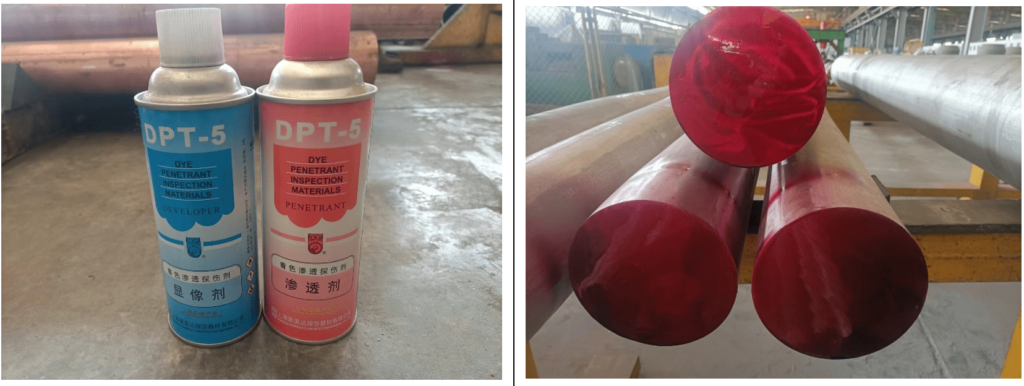In the world of quality control, safeguarding the safety and reliability of critical materials, components, or structures without causing any damage to them is not just a matter of choice, but a requirement.
Dye Penetrant Inspection (DPI) stands as a method to achieve this very goal. DPI is a non-destructive testing (NDT) technique used to assess the properties and integrity of materials, aiming to uncover surface-breaking defects or discontinuities.
In this concise guide, we will introduce you to the concept of dye penetrant inspection and explore its essential components and key elements in the inspection process.
What Is Dye Penetrant Inspection?
Dye Penetrant Inspection, also commonly referred to as Liquid Penetrant Inspection (LPI), is a non-destructive testing method. The inspector uses a dye or liquid to a surface in order to identify any potential defects in the subjected item, such as airline cracks and micro-porosity to other forms of discontinuities.
Today, it is one of the most common inspection methods, highly versatile, and allows the inspector to use the testing method without damaging the object they’re inspecting.
Dye Penetrant Inspection Procedure and Methodology
The DPI process follows a systematic methodology that follow several crucial steps. Below, we present a simplified outline of the procedure:
Surface Preparation: The inspector will clean the tested item by applying dipping, spraying or brushing. This is to ensure that the penetrant later can effectively access the surface defects.
Penetrant Application: The selected penetrant, which can be either a visible dye, a fluorescent penetrant, or a water-washable penetrant, is then applied to the surface. The choice of penetrant depends on considerations such as the environment, surface finish, and customer requirements.
Dwell Time: The penetrant is allowed to soak on the surface for a specified period, during which it seeps into any surface defects. Any excess penetrant is then removed, and the surface is dried.
Developer Application: The developer is applied to the surface, drawing out the penetrant from any flaws. This process renders the defects visible, providing a visual indication of their presence under ultraviolet or white light.

The penetrant are then classified based on their sensitive level. Generally the inspector will employ dye penetrant techniques to identify issues such as:
- Leakage
- Imperfections in joints
- Material surface porosity
- Fractures
- Various types of cracks, including those resulting from fatigue, hairline cracks etc.

What Are the Advantages of DPI?
DPI’s reach extends across various industries, and is frequently used in sectors where safety, reliability, and compliance with stringent standards are non-negotiable, from aerospace industry, electronics industry, oil and gast industry to the automotive sector. The advantages of the process include:
1. Cost Effective and Early Detection
DPI is highly effective in the early detection of surface defects, preventing their progression into critical problems that might jeopardising the safety or performance. Recognising these defects in the initial stages of manufacturing is instrumental in avoiding expensive rework, product failures, and potential liability concerns.
2. Versatile Solution
The DPI can be used on a range of materials, including ferrous and non-ferrous, conductive and non-conductive, as well as magnetic and non-magnetic, making it very versatile.
3. Quick Inspection
The DPI offers the advantage of a quick and comprehensive inspections of surface areas. It can be used to examine large components or expansive structures, making it a valuable inspection method for industries where inspections on a larger items are required.
What Are the Disadvantages of Dye Penetrant Examination?
Although DPI is an effective method, it does come with some disadvantages, as highlighted below.
Limited to Surface Defects
The DPI is designed to detect surface defects. As a result, it may not be suited for identifying defects that lie beneath the material’s surface. For such subsurface defects, alternative testing methods like radiographic or ultrasonic testing would be more appropriate.
Requires Experienced Inspectors
The DPI involves a series of precise steps, including the application of penetrant, dwell time, excess penetrant removal, and developer application. It’s important that the inspector is skilled and well-trained to ensure that the penetrtant reach the surface defects effectiveley and that the results are interpreted correctly.
Subjectivity in Visual Inspection
The DPI relies on visual inspection to identify indications of defects. As a result, the interpretation of these signs can be subject to individual judgment and may vary based on the inspector’s level of experience and the lighting conditions at the time of inspection.
Conclusion: Dye Penetrant Inspection (DPI) for Quality Assurance
Dye Penetrant Inspection is a non-destructive method that enables businesses to evaluate the properties and integrity of materials, uncovering surface-breaking defects or discontinuities without causing harm to the tested item. At HQTS, we have over a decade of experience assisting businesses in inspecting their products and employing NDT testing methods across more than 40 countries worldwide. Whether you require assistance in inspecting goods at the manufacturer’s location or on-site, contact HQTS for consultation, or a quotation today.




